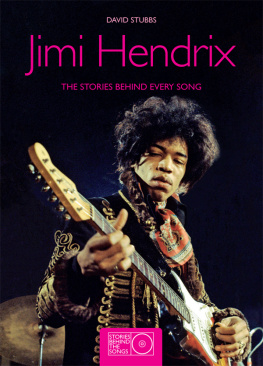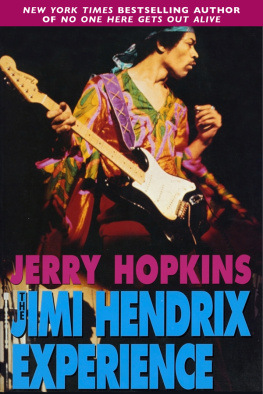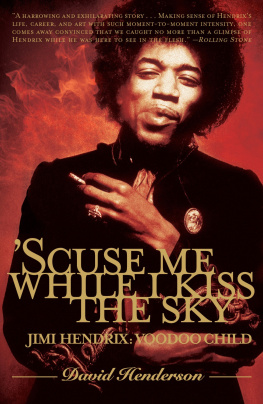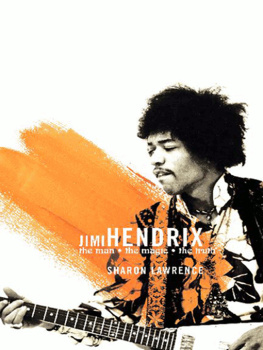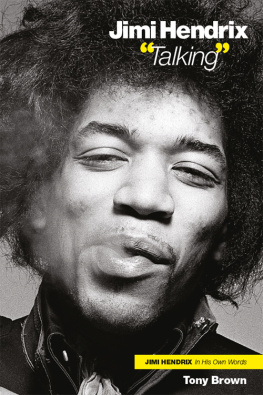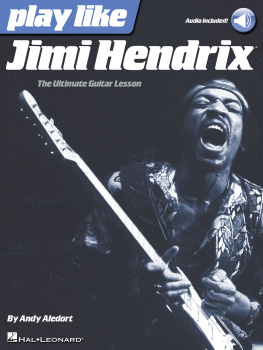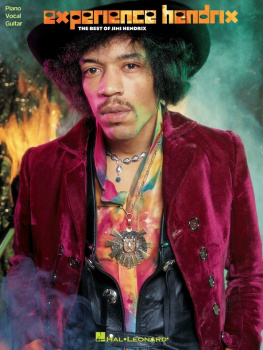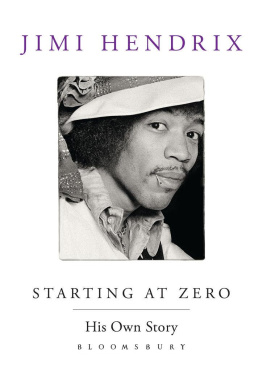
THIS IS A CARLTON BOOK
This second edition published in 2010 by
Carlton Books Limited
20 Mortimer Street
London W1T 3JW
10 9 8 7 6 5 4 3 2 1
First published in 2002
Text copyright 2002 and 2010 David Stubbs Design copyright 2010 Carlton Books Limited
All rights reserved. This book is sold subject to the condition that it may not be reproduced, stored in a retrieval system or transmitted in any form or by any means, electronic, mechanical, photocopying, recording or otherwise without the publishers prior consent.
eISBN 978-1-78011-197-1
CONTENTS
INTRODUCTION
Jimi Hendrix was, arguably, the greatest rock star of all time. Elvis Presley was the biggest seller, The King, but only those who believe that the first word in rocknroll was also the last would argue that the genre failed to progress following Elviss Sun Studio recordings.
Lennon & McCartney and Jagger & Richards were partnerships: solo, they fell short of the heights theyd reached as the Beatles and the Stones respectively. Bob Dylan brought literacy and an attitude to rock music that helped drag it out of its showbizzy infancy into the 1960s proper. He may have been popular musics greatest poet (though Dylan himself argued for Smokey Robinson). Yet, skinny and scabrous, his music lacked only the sort of physical and sensual quality that the Byrds, or Hendrix himself, were able to bring to covers of his work. David Bowie and Prince were chameleons, harlequins. Meanwhile, following punk and the diversity of the postmodern, late twentieth century/early twenty-first century music scene, no single figure, or even band, has been able to dominate and even innovate in the manner of rocks ancient, legendary figures. All of the major tectonic shifts have occurred, the rock landscape is set in place, the smoke is clearing and Hendrixs legacy and supremacy are increasingly self-evident.
More than any other figure, Jimi is the magnificent embodiment of all of rock musics ambitions. His early, and not inevitable death at the age of 27 is appallingly convenient in that it freezes him at his peak, preserves his iconic status. Age shall not wither, fatten or embarrass him, nor make him resort to a bad hair weave. He remains, then as now, rocks alpha male, the man. He cut the shape and set the tone by which all subsequent guitar heroes were measured and generally found wanting, until finally a newer generation decided it might be wiser not to attempt guitar heroism at all but busy themselves in other musical ways entirely.
Technically, its possible that Hendrix wasnt actually the most proficient guitarist on the planet. Its interesting, that, unlike Eric Clapton, Jimmy Page et al, he didnt really bother with the acoustic guitar. Some musos suspected him of hiding behind an arsenal of gimmicks and gadgets, of cranking up his Marshall amps to conceal technical blemishes and bum notes. Yet, when Hendrix first hit the London scene in 1966, the proclaimed rock gods of the day didnt bother to go into denial about him, or even to turn green with envy. They simply fell at his feet. They knew. When Pete Townshend and Eric Clapton arrived late at an early Hendrix show at Blaises club to check the new American guy out, they met Jeff Beck coming out, who simply rolled his eyes. Townshend asked him if Hendrix was that bad. Beck replied, No, hes that bloody good!
Hendrix himself never indulged in bragging and, unlike his contemporary Muhammad Ali, resisted efforts to call him The Greatest. Many who met him were surprised at how slight and unassuming he seemed in person. Thats because, onstage, he projected the image of an 800 pounds behemoth.
Hendrix was a fine guitarist but, more importantly, he was a master of the new electric energy which would be unleashed across the late 1960s as rock jettisoned the nroll and went supersonic. His arrival on the scene coincided with the introduction of Marshall amps, developments in studio technology and techno-boffins such as Roger Mayer, who introduced to Hendrix a welter of new devices such as the Octavia and wah-wah. Others such as the Small Faces, Cream and Frank Zappa had used these gizmos, but to nothing like the devastating effect that Hendrix did. It was as if, in terms of sonic arsenal, the music had leapt from musket fire to the thermonuclear bomb overnight. Audiences were astounded at the hurricanes of sound he hurled at them from all sides. A young Allan Jones, later editor of UK music magazines Melody Maker and Uncut, recalled seeing Hendrix in Cardiff in 1967: The noise was terrific. It seemed to suck the air out of our lungs, left us scalded, altered.
Yet the effect was spellbinding, the noise never repellently cacophonous but sculpted liquid and fire expertly shaped in mid-air as if by a glass blower. His working methods were a mystery, even to those close to him. Said Eric Barrett, Jimis long-time tour manager: If I tried to test his equipment, all I got was feedback. Jimi could control it all with his fingers, and I still dont know how he did it. Or, as George Clinton put it, The way he could control feedback and make it sound so symphonic truly transcended logic.
Hendrix was greeted at the time as some yeti-like unknown force of nature, in borderline racist terms as a wild man. However, as Charles Shaar Murray has so eloquently argued in his book Crosstown Traffic: Jimi Hendrix And Post-War Pop (Faber & Faber, 1989), Hendrix drew from a whole range of twentieth century musical traditions, and could be claimed by any one of them. He drew on the primal energy of the blues, his first love hed spent a lot of time in the deep South as a child, and learnt some of his later techniques such as how to bend notes, from bluesman Albert King. He earned his spurs on the chitlin circuit, polishing his R&B licks, learning the rudiments of funk and soul as well as the obligations of showmanship. With his penchant for free and lengthy improvisation, he admired, and was admired by, the jazzmen of the day. He jammed with blind saxophonist Roland Kirk, and would almost certainly have worked with Miles Davis had he lived. Its arguable, also, that in order to seek out Hendrixs true twentieth century peers you have to look outside rock to jazz, to freewheeling atonalists like Ornette Coleman and John Coltrane, driving themselves and their music to the absolute boundaries and expanding the known musical universe.
He also drew from less likely sources the folk/rock of Bob Dylan, whose frizzy mane of hair he emulated, whose lyrics he worshipped and whose cracked, unlikely voice persuaded him that you didnt need sweet tones to cut it as a vocalist. He even dug the daft world of 1960s pop he paid attention to the showmanship of Johnny Halliday and even Engelbert Humperdinck, when unwisely billed alongside the latter early on. Indeed, it was as a pop phenomenon that Hendrix was first launched on the world.
Still, Hendrix would never have been comfortable settling into any musical tradition. His roving, restless spirit made him a futurist by nature. Hence he was first drawn, for the time being at any rate, to rock music, then in its young and molten phase, a music in which the often opposite dynamics of populism and artistic innovation were temporarily at least married.
Emulating his warrior Native American ancestors, Hendrix used to paint his guitars before going onstage. In much the same way he was a painter of sound. The palate of sonic colours he drew on was immense, thanks largely to his own virtuosity, curiosity and manual dexterity (Hendrix was gifted with outsize hands and thumbs). The fact that he was left-handed but played a right-handed guitar upside-down was further testament to his ability to improvise on the instrument. It was also down to the assistance of sound engineers, primarily Eddie Kramer, who helped him realise his visions in the studio. Prior to Hendrix, and all too often after him, rock songs were set to the basic accompaniment of rhythm, melody and perhaps a fuzzy blast of guitar by way of colouring in. The likes of the Beatles and the Beach Boys had been innovators in the use of the studio as a musical instrument, but Hendrix dwarfed both of them. With a relative minimum of instrumental and technical resources, he made music as vivid and lavishly variegated as any great classical tone poem. His songs were physical happenings and things seemed to happen physically to those who were exposed to them. Its impossible to merely listen to what Hendrix does, commented Frank Zappa. It eats you alive.
Next page
